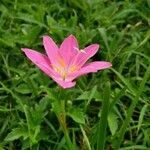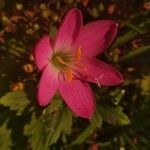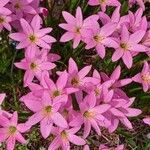Leaf blade dull green, to 5 mm wide. Spathe 2–2.8 cm. Flowers erect to slightly inclined; perianth rose pink, spreading, funnelform, 2.7–2.8 cm; perianth tube green, 0.2–0.3 cm, increasing in diam., ca. 1/10 or less of perianth length, ca. 1/5 filament length, ca. 1/8 spathe length; tepals not reflexed, distalmost not erect; stamens diverging, in 2 slightly subequal sets with anthers overlapping ca. 90 percent; filaments filiform, 1–1.7 cm; anthers 3–6 mm; style 1.8–2.7 cm, longer than perianth tube; stigma 3-fid, exserted ca. 1–5 mm beyond anthers; pedicel 1.5–3.2 cm, usually exceeding spathe. 2n = 24.
Perigone 3-3.5 cm long, pink.



